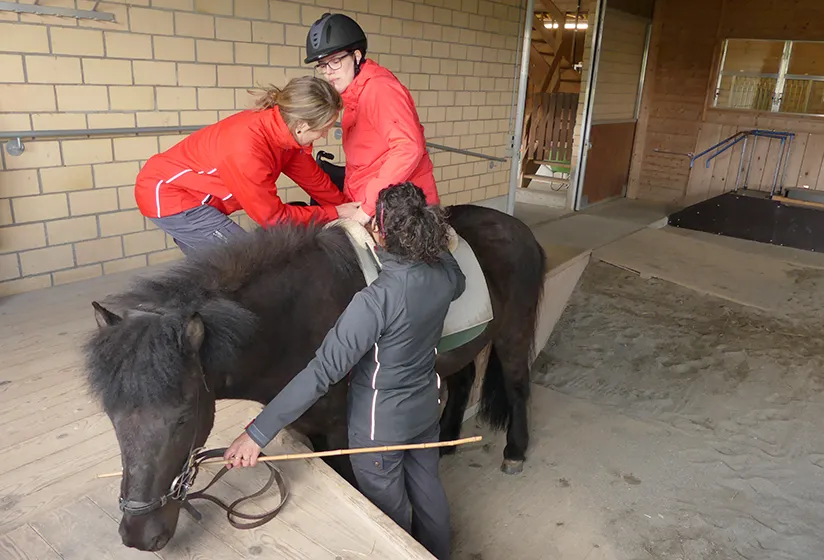Equine Therapy
How it works
The movements of a horse’s back are primarily relaxing for the patient, but also have an invigorating and stimulating effect. The patient sits on a wide saddle on the back of a horse, which the guide leads the guide in a walking gait. This sitting position and the three-dimensional movement of the horse have a positive effect on cramped muscles in the torso and legs. The healthcare professional supports the patient and gives instructions for exercises. In addition, they can use their hands to induce the relevant pelvic movement in the patient. The muscles constantly alternate between tension and relaxation.
As a result, Equine Therapy can be used in pursuit of diverse therapeutic objectives:
- To alleviate pain or control muscular tension
- To regulate the muscle tone (Lechner 2003, see publication).
- To strengthen the axial musculature
- To train one’s balance, coordination and posture reactions of the torso
- To get a positive, motivational psychological effect

Equine Therapy at the Swiss Paraplegic Centre
Horse-specific requirements
- Mental and emotional fitness for the concentrated acceptance and following of commands
- Building the horse’s muscles and endurance
- Ability to remain calm and patient on the ramp
- Trust with respect to the various pieces of therapeutic equipment (walking sticks, wheelchairs, etc.)
- Willingness to be led at neck and shoulder height on both sides
- Impervious to the patient’s spasticity and imbalance
- Able to handle being surrounded by several people
- Ability to keep calm in the face of all sorts of environmental conditions and noises
Cost coverage and prescription
After the acute phase is complete, Equine Therapy can be undertaken in outpatient and inpatient care. It is primarily given to patients with neurological conditions such as spinal cord injury, MS or stroke. In some cases, the costs of Equine Therapy may be covered by health insurance or disability insurance, for instance in Switzerland for adults with multiple sclerosis and children with cerebral palsy and trisomy 21. Third-party financing should be considered for other diagnoses.
As is the case with any other form of therapy, in this country this therapy must be prescribed by a doctor and performed by physiotherapists with additional training in Equine Therapy. This usually takes the form of further training in Künzle-style equine therapy (K-hippotherapy).
Inpatients with spinal cord injury are covered by the clinic’s daily rate.
The therapeutic team consists of the patient, a trained therapy horse, an equine therapist and a horse guide.
Equine therapy usually takes place once a week. It can take place outdoors or in the hall. The duration of treatment depends on the resilience and capacity of the patient, but lasts around 30 minutes. The patient will be held securely by the equine therapist throughout the procedure. Transfer, i.e. the transition from the horse, is an essential part of the treatment.

Equine Therapy at the Swiss Paraplegic Centre
Patient requirements
The individual should have sufficient sitting stability and torso control and be able to move their head independently. Individual suitability should be determined by trained staff. Children should be at least four years old.
The Equine Therapy team
Equine therapy was first introduced at the SPC in 1994, at the Eyhof Farm Estate. Our team consists of the following:
- four horse guides
- eleven equine therapists
- nine Iceland horses
Fees
The fees for K-hippotherapy are approx. CHF 140.00 (excluding initial assessment) for each treatment session, depending on insurance.
Publication
Lechner H E, Feldhaus S, Gudmundsen L, Hegemann D, Michel D, Zäch G A, Knecht H. The short-term effect of hippotherapy on spasticity in patients with spinal cord injury. Spinal Cord. 2003 Sep; 41(9):502–5.
The following may also be of interest to you
Werden Sie jetzt Mitglied und erhalten Sie im Ernstfall 250 000 Franken.

